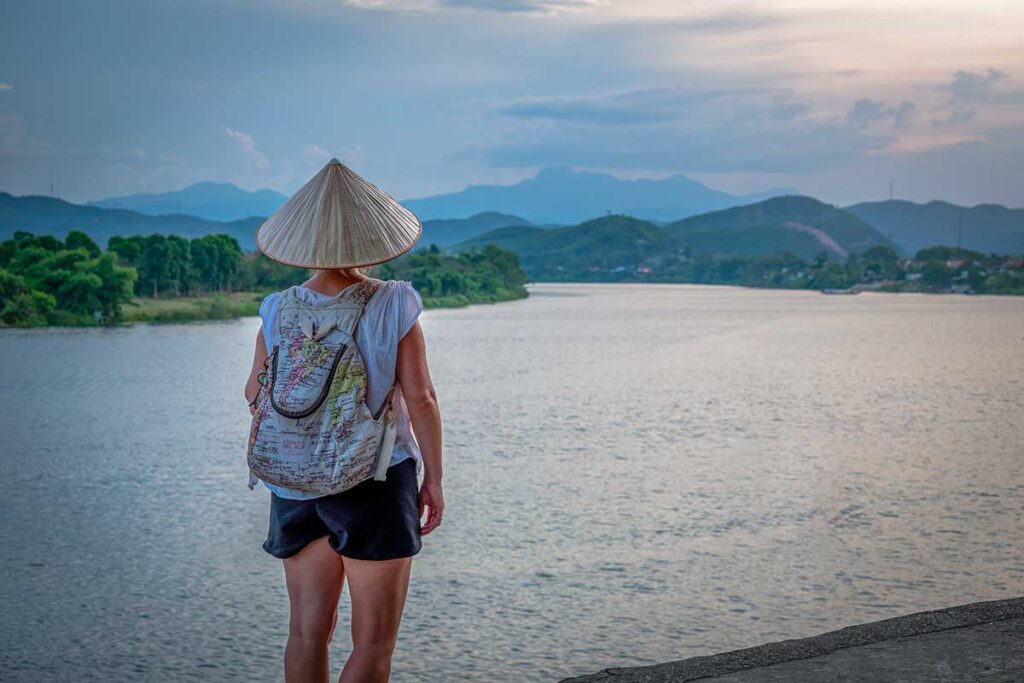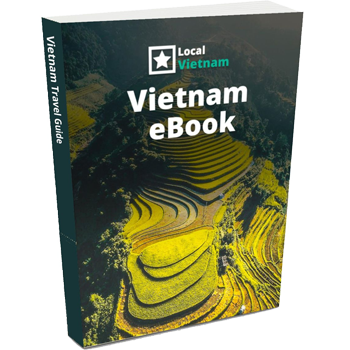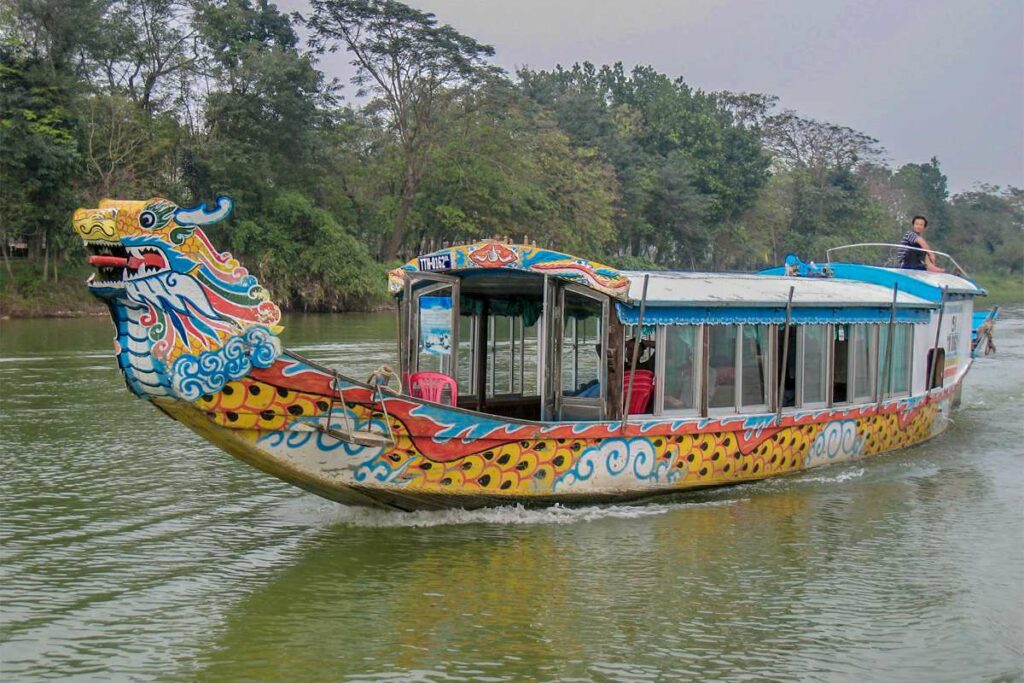What is the Perfume River?

The Perfume River (Sông Hương) stretches about 80 kilometers, originating in the Truong Son Mountains. It flows through forested hills, small villages, and past historic sites before reaching the heart of Hue and eventually emptying into the Tam Giang Lagoon. The name “Perfume River” comes from the scented blossoms and herbs that once floated downstream from mountain orchards—especially in autumn—carrying a natural fragrance that gave the river its poetic name.
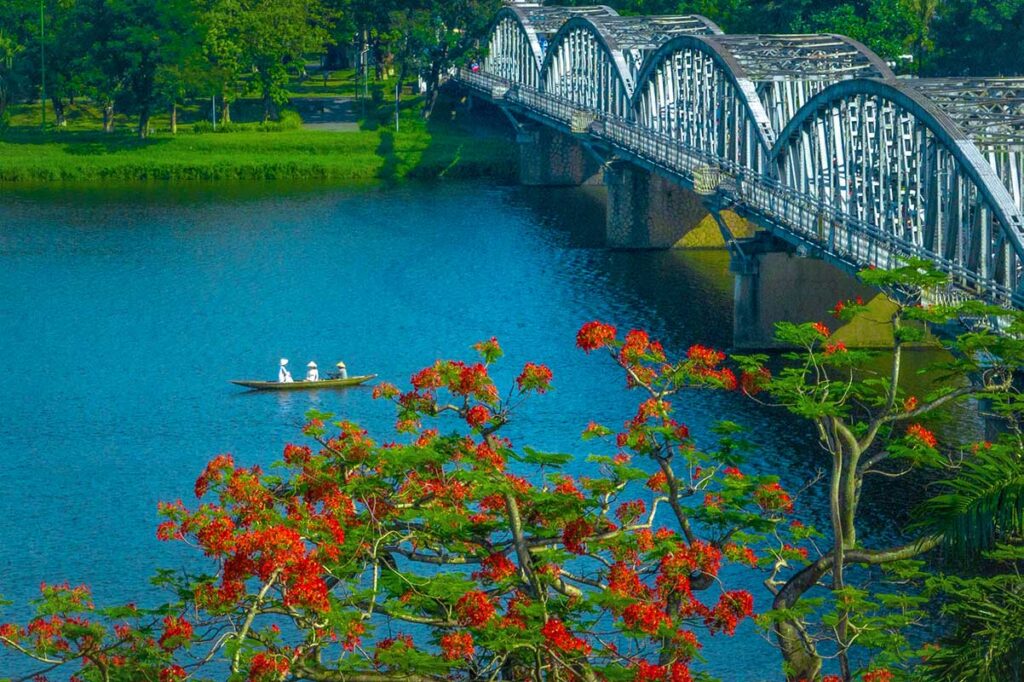
Today, while the scent may have faded with urban growth, the river remains deeply woven into Hue’s daily rhythm. Locals gather along its banks to relax, fish, exercise, or meet with friends, and the river still plays a role in spiritual ceremonies, especially those involving nearby temples and pagodas.

History and royal connections
Long before Hue became Vietnam’s imperial capital, early settlements were drawn to the Perfume River’s fertile banks and strategic location between the mountains and the sea. But it was Emperor Gia Long—the first ruler of the Nguyen Dynasty—who formally moved the capital to Hue in the early 1800s. From that moment, the river took on an even deeper importance, becoming the symbolic and physical centerpiece of royal life.
The Nguyen emperors deliberately chose sites along the river for their palaces, pagodas, and tombs. According to feng shui, the river’s flow and the surrounding hills offered harmony between heaven and earth—ideal for sacred architecture. That’s why many of Hue’s most important landmarks, like the Thien Mu Pagoda and the tombs of Minh Mang and Gia Long, were built along the riverbanks.
Over time, the Perfume River also became a powerful cultural symbol. Its gentle flow, misty mornings, and golden sunsets have inspired countless poets, painters, and musicians. Traditional Hue music—once performed in royal courts—often draws on the imagery of the river, and it continues to shape the city’s identity as a place of reflection, elegance, and quiet strength.
Activities along the Perfume River
To truly experience the charm of Hue, spend time along the Perfume River. This isn’t just a scenic waterway—it’s where local life, history, and nature blend together. Whether you’re drifting on a dragon boat, cycling between temples, or strolling under the glow of evening lights, the river is a central part of daily life and one of Hue’s most rewarding places to explore.
1. Dragon Boat Cruises
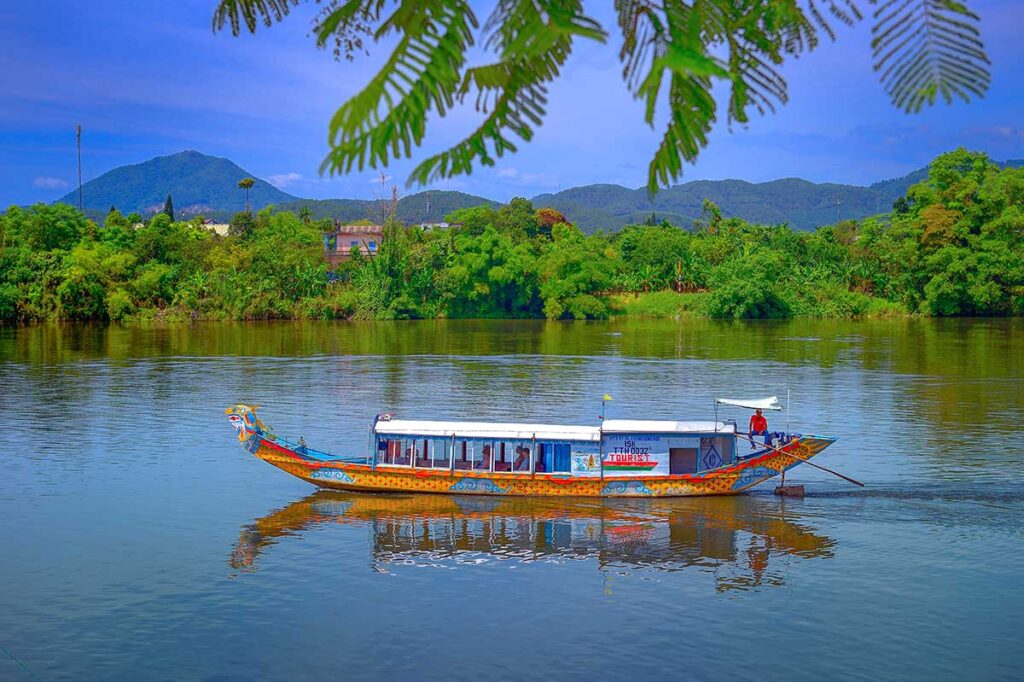
One of the most iconic ways to enjoy the river is by dragon boat. You can take a short ride from the city center to Thien Mu Pagoda or join a longer cruise to visit imperial tombs like Minh Mang or Gia Long. Boats depart from Toa Kham Pier, and you can choose from basic rides or book a sunset or dinner cruise for a more atmospheric experience.
Perfume River Dragon Boat Tour in Hue-Half Day Private Tour
- Includes Dragon boat cruise, Thien Mu Pagoda, Minh Mang and Khai Dinh tombs.
- Experience Private half-day tour with hotel pickup and flexible itinerary.
3. Evening walks by the river

In the evening, the riverbanks come alive. Locals and travelers gather along Le Loi Street and near Trang Tien Bridge, which lights up beautifully after dark. There are riverside paths, cozy benches, and occasional live music or street performances. Food stalls pop up, and the relaxed vibe makes this one of the best places in Hue to unwind at night.

A small night market sometimes sets up nearby, adding even more atmosphere with snacks, souvenirs, and local products.
4. Cycling Paths
Hue is one of the few cities in Vietnam with proper riverside cycling paths. You can rent a bike and ride from the Imperial City all the way to Thien Mu Pagoda, following a peaceful route along the Perfume River. It’s a great way to see gardens, temples, and quiet corners of the city—without traffic stress.
5. Vong Canh Hill Viewpoint
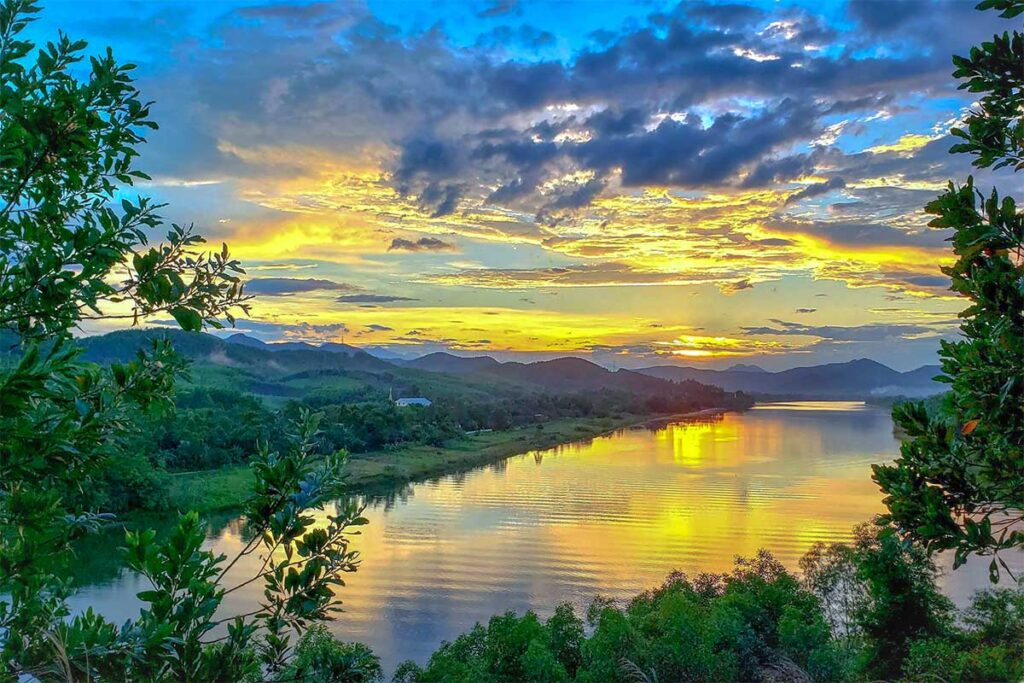
If you want the best panoramic view of the Perfume River, head to Vọng Cảnh Hill. Located a few kilometers outside the city, this quiet hilltop was once a favorite spot of the Nguyen emperors. From here, you’ll see the river winding through forested hills, with tombs and temples scattered in the distance. It’s especially beautiful at sunrise or sunset, and popular with photographers and local couples alike.
Temples and tombs along the Perfume River
The Perfume River flows past many of Hue’s most iconic temples and royal tombs. Most were deliberately built along the riverbanks by the Nguyen emperors, who followed strict feng shui principles when choosing these spiritual and scenic locations.
Thien Mu Pagoda

Thien Mu Pagoda is one of the most famous landmarks in Hue, perched on a hill overlooking the river. This historic pagoda with its seven-story tower has become a lasting symbol of the city.
Tomb of Tu Duc

The mausoleum of Emperor Tu Duc is an elegant complex of pavilions, courtyards, and a lake. Designed by the emperor himself, it was used as a retreat long before his death.
Hon Chen Temple
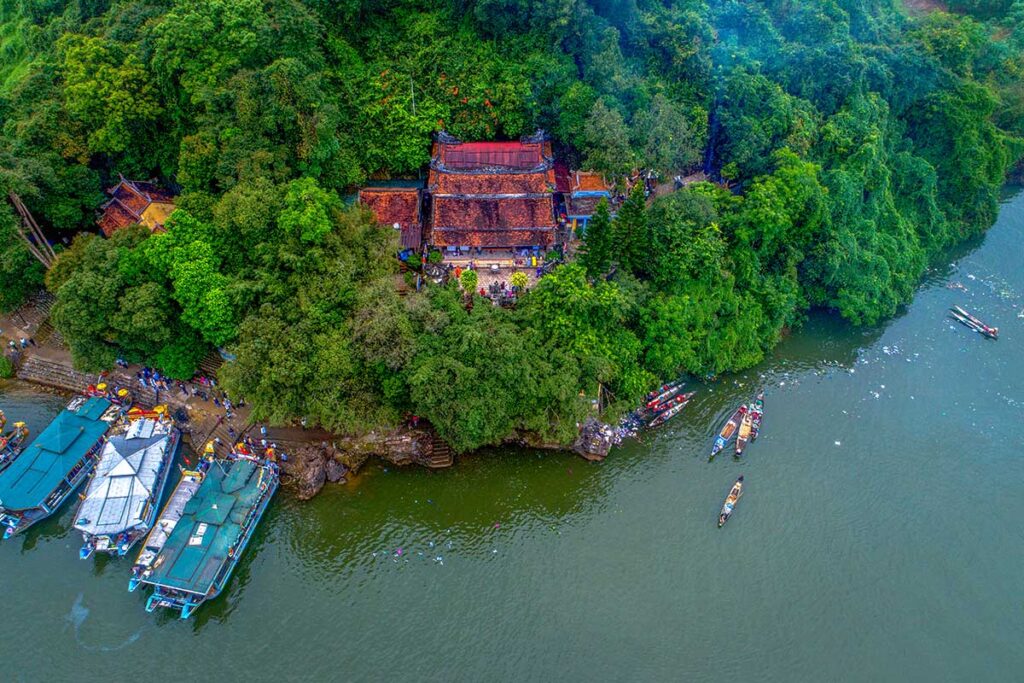
Hon Chen Temple, also known as Hon Chen Shrine, is a sacred site dedicated to the Mother Goddess Thien Y A Na. Located halfway up Ngoc Tran Mountain, it plays a central role in the annual Hon Chen Festival.
Tomb of Thieu Tri
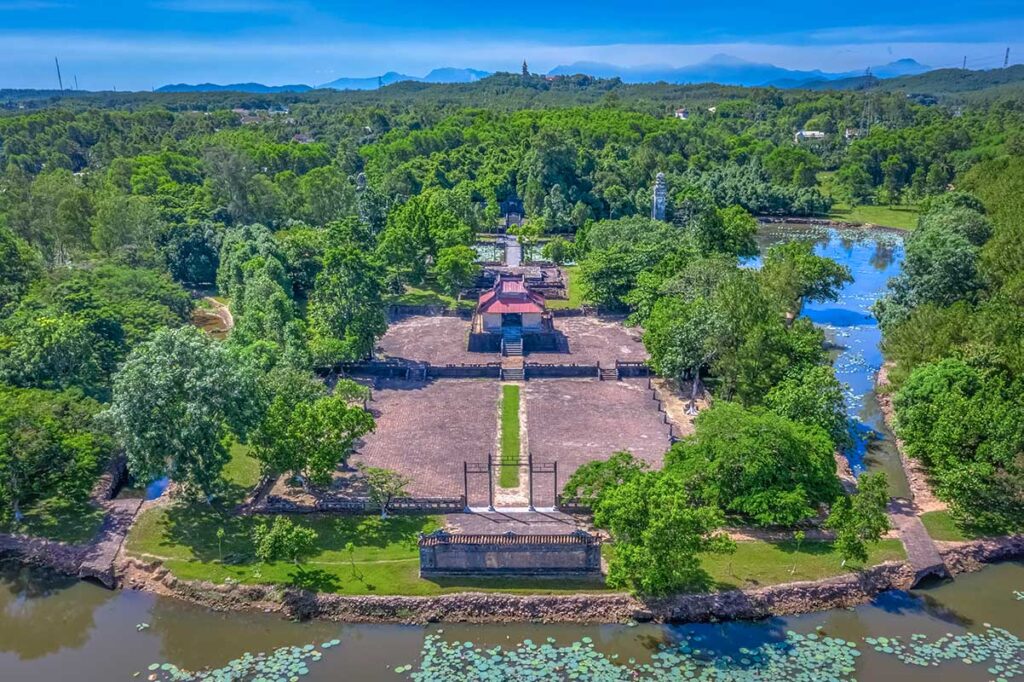
The Tomb of Thieu Tri is one of the quieter royal mausoleums, known for its open layout and peaceful setting. It’s often overlooked by tourists but offers a serene, uncrowded experience.
Tomb of Khai Dinh
The Mausoleum of Emperor Khai Dinh stands out for its fusion of Vietnamese and European architecture. Built with concrete and elaborate decorations, it’s the most modern and visually striking tomb in Hue.
Tomb of Minh Mang
Surrounded by pine forests and lakes, the Tomb of Minh Mang is one of the most impressive imperial sites in Vietnam. Its symmetrical design and tranquil setting reflect Confucian ideals.
Tomb of Gia Long
The Tomb of Gia Long is the most remote of Hue’s royal mausoleums, set in a quiet landscape of hills and rivers. Though less visited, this tomb offers a deeply atmospheric and reflective experience.
Tips for visiting the Perfume River
To make the most of your time along the Perfume River, it helps to know when to go, where to stay, and how to combine it with other highlights in Hue. These tips will help you plan a smoother and more enjoyable visit.
Best time to visit the river
The river is most beautiful early in the morning when the air is cool and calm, or in the late afternoon when the sun sets over the water. Avoid midday if you’re planning to walk or cycle, as the heat can be intense—especially in summer.
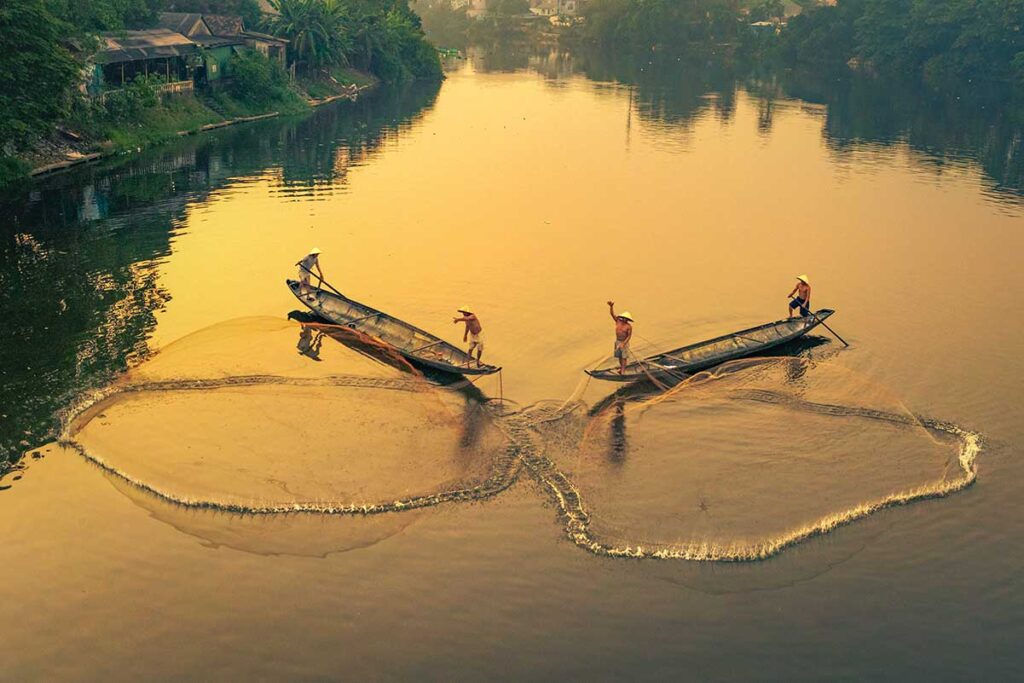
Don’t miss the Hon Chen Festival
If you’re in Hue during the 3rd or 7th lunar month (usually around March or August), try to catch the Hon Chen Festival. Dozens of dragon boats form a colorful river procession for the Mother Goddess Thien Y A Na. It’s one of Hue’s most unique cultural events.
Stroll or photograph Trang Tien Bridge
Trang Tien Bridge is the most iconic bridge crossing the Perfume River and a local landmark in its own right. At night, it’s beautifully lit in shifting colors—great for evening strolls and river photography.
Stay by the riverside for views and access
Booking a hotel or guesthouse along the river (especially near Le Loi Street or in Kim Long ward) gives you easy access to dragon boat piers, riverside paths, and sunset views. Some riverside stays even offer boat rides or bike rentals.
Plan an ideal half-day or full-day route
For a relaxing half-day, take a dragon boat ride to Thien Mu Pagoda and cycle back along the riverside path. A full-day route could include visits to Minh Mang or Khai Dinh tombs by boat or car, with lunch along the river and a sunset walk by the bridge.
Combine river time with city sights
The Perfume River runs right through the heart of Hue. It’s easy to combine a boat ride or riverside walk with nearby attractions like the Imperial Citadel, Dong Ba Market, or Nguyen Dinh Chieu walking street. Just cross the bridge or follow the riverside roads.
